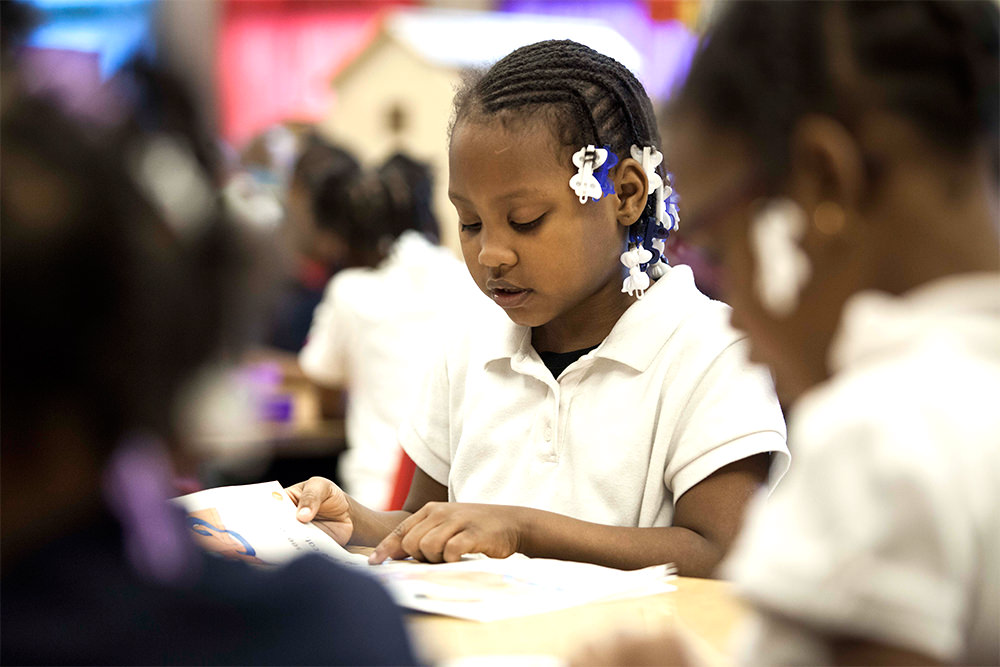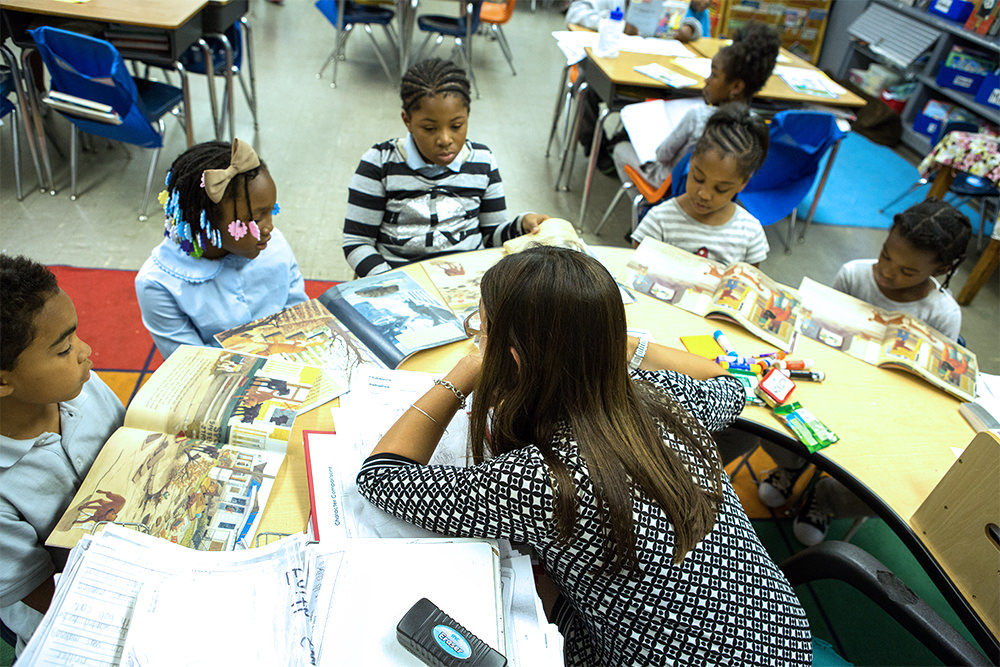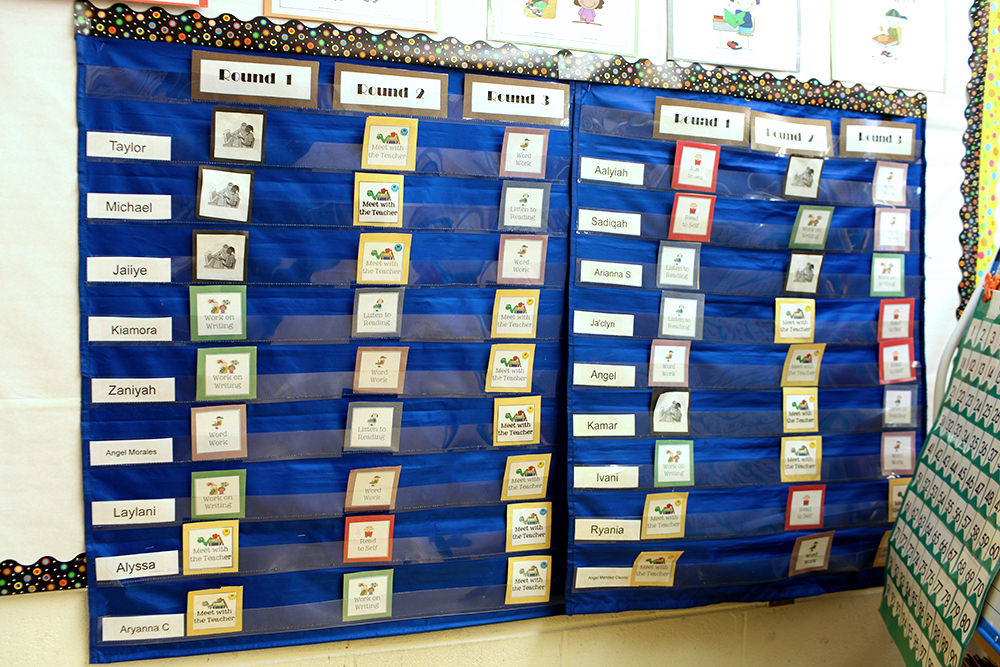
Guided Reading is a powerful and efficient tool to target your reading instruction to meet the specific needs of your children. To get the most out of your Guided Reading time, you’ll need to do some research and planning up front.

As you are setting up your classroom and teaching children the routines and procedures of working independently, meet with children one on one to figure out:
This preparation doesn’t just happen at the beginning of the year. Your children will grow as readers, and you’ll need to be prepared to track and respond to their changing needs as the year goes on.
Assessing children and forming groups are one part of preparing for Guided Reading. The other part is planning thoughtful lessons. Choose teaching points and books that address the specific needs of the different groups. Plan what you will do and say before, during, and after reading.
Learning to read is a developmental process. Most readers move through a similar sequence of behaviors as they learn to read, although not necessarily at the same pace. Just like not all babies learn to walk or talk at the same time, not all children learn to read at the same age and grade. Reading development is influenced by experience, environment, and normal variations in maturity. Effective reading instruction targets the reading strategies and skills that are appropriate for each reading stage.
| Pre-Emergent Readers | Emergent Readers |
|---|---|
| Pre-emergent readers are just beginning to understand how books work. They enjoy being read to, and may pretend to read and retell favorite stories. They are working on book handling skills, turning pages and looking at pictures. Children at this stage need many rich and enjoyable experiences with books. | Emergent readers understand that in addition to pictures, print carries meaning in a book. They notice environmental print and begin to learn common words like “mom” and “like.” They remember patterns in books and use them to read. They understand that spoken words are made up of sounds and are beginning to learn letter sound relationships. |
| Early Readers | Transitional Readers |
|---|---|
| Early readers can read and understand simple books. They have different strategies to figure out and confirm new words. Early readers learn to pay attention to all three cueing systems – visual, syntax, and meaning - asking themselves: Does it look right? Does it sound right? Does it make sense? Early readers need to know many sight words automatically. They can retell stories and talk about messages the stories contain. | Transitional readers can read simple stories with familiar text structures with increasing fluency. They know many sight words automatically and can decode most familiar words. They are still learning to decode bigger words and increase fluency and vocabulary. They don’t rely as much on pictures and can read longer, more complex texts. They enjoy series books including short chapter books and stories with more developed characters. |
| Early Fluent Readers |
|---|
| Early fluent readers are ready to take on a wide range of texts. They are reading to gain new knowledge and understanding of the world. They consistently self-monitor and cross check different sources of information. They can read most words automatically and are working on expanding vocabulary, gaining fluency, and working with increasingly complex texts. |
The hard work that children do when they are learning to read is different for each stage of reading development. This means that what we focus on and spend more time on in Guided Reading should change depending on the reading stage a child is in.
For example, early readers are doing a lot of hard work in decoding. Yes, they still need to understand the book – we don’t want to ignore comprehension entirely – but the hard work and bulk of their problem solving should be around decoding. That’s where they need the most support and instruction in Guided Reading. And where we should spend the most time before, during, and after the reading. This is different for children who are in the early fluent stage. They may still run into words that are tricky, but their hard work is around vocabulary and comprehension. And so that’s where our instruction should focus.
Before you can group your children for Guided Reading, you’ll need to spend some time getting to know them as readers. Gather information to determine reading levels, strengths and needs of children, and information on their reading identities. You can do this through formal assessments such as running records, phonemic awareness and spelling inventories, interest inventories, and writing samples. You can also gather information from talking with children, observing behaviors, and other informal assessments.
Assessing children is an ongoing process. Continuously check in on your readers as their skills grow and needs change through the year.
The types of assessments you do will depend on children’s reading stages. Here are some of the things you’ll need to assess for each stage of reading development:
Working with Emergent Readers Use this document to identify entry and exit requirements for this reading stage, select appropriate texts for this reading stage, determine appropriate assessments, and plan instructional activities that support these readers throughout the literacy block (not just in guided reading).
Working with Early Readers Use this document to identify entry and exit requirements for this reading stage, select appropriate texts for this reading stage, determine appropriate assessments, and plan instructional activities that support these readers throughout the literacy block (not just in guided reading).
Working with Transitional Readers Use this document to identify entry and exit requirements for this reading stage, select appropriate texts for this reading stage, determine appropriate assessments, and plan instructional activities that support these readers throughout the literacy block (not just in guided reading).
Working with Early Fluent Readers Use this document to identify entry and exit requirements for this reading stage, select appropriate texts for this reading stage, determine appropriate assessments, and plan instructional activities that support these readers throughout the literacy block (not just in guided reading).
Reading Level Correlation Chart Use this chart to correlate reading levels across different assessments.
Reading Level Recording Sheet Record your class' reading levels on this form.
“The purpose of small group instruction is to meet the needs of all students in your classroom in a powerful way that will accelerate their learning. Work with your students at their instructional reading level in small groups. This means that you find a text that can be read at 90 to 94 percent accuracy with good comprehension and some fluency. If the text is harder than this, the child has to work too hard (and often, so do you). If the text is much easier than this, there’s not enough work for the child to do. You don’t want to work with a small group on a text that is too easy for them; it’s too much work to carve out the time to work with that small group.” - Debbie Diller, Making the Most of Small Groups: Differentiation for All
Teach Guided Reading with texts at the reader’s instructional reading level. This is where readers are able to decode and navigate most of this text and are therefore able to understand most of what they read (but not all). It gives them the room and opportunity to learn how to flexibly use and apply the skills and strategies they have been taught.
Assess children to figure out their instructional and independent reading levels. Record their levels on a class list. The following guidelines will help you determine if the text is easy and good for independent reading, too hard, or just right for Guided Reading:
Independent: The level at which a reader can read text with 95-100% accuracy (i.e., no more than one error per 20 words read). Independent reading level text is relatively easy text for the reader.
Instructional: The level at which a reader can read text with 90% accuracy (i.e., no more than one error per 10 words read). Instructional reading level engages the child in challenging but manageable text.
Frustration: The level at which a reader reads at less than a 90% accuracy (i.e., more than one error per 10 words read). Frustration level text is difficult text for the reader.
As you meet with children in Guided Reading, you are continually reassessing their reading skills and behaviors. Children’s reading skills develop at different rates, so it is important to make sure that you are grouping children in ways that meet their current needs and allow you to teach at their current instructional level.
Flexible grouping is good for your classroom culture, too. Keeping groups flexible sends the message to children that strengths and needs change all the time. Unlike the “high,” “middle,” and “low” reading groups of the past - in which everyone knew who was where - flexible groups don’t pigeon-hole and label children’s abilities.
Use these ideas to help you keep your groups flexible:

After you’ve assessed the children in your class and have good information on their reading strengths and needs, you are ready to form Guided Reading groups. Group children with similar skills so that you can meet their needs in the most efficient and effective ways. Here are some guidelines for forming groups:
After you’ve grouped your children for Guided Reading, create a schedule for when you are going to meet with each group.
Here are some things to keep in mind:
| Group | # of sessions/week |
|---|---|
| Level B | 3 |
| Level C1 | 3 |
| Level C2 | 2 |
| Level D | 1 |
| Level F | 1 |
| Week of ______ | Monday | Tuesday | Wednesday | Thursday | Friday |
|---|---|---|---|---|---|
| 1st Session | |||||
| 2nd Session | |||||
| 3rd Session |
| Week of ______ | Monday | Tuesday | Wednesday | Thursday | Friday |
|---|---|---|---|---|---|
| 1st Session | |||||
| 2nd Session | |||||
| 3rd Session |

Once you have your groups formed for Guided Reading, you can begin to plan your lessons. Successful lessons only happen with careful planning. The lesson planning template is a tool for supporting your thinking through this important phase of a Guided Reading lesson. Use a planning template to decide what you will do before, during, and after reading the text in the Guided Reading lesson. On the lesson planning template, record the actual language that you’ll use when teaching the lesson. This will help to conserve time and ensure a high quality lesson. Guided Reading lessons are 15 to 20 minutes long; careful planning will help you stay mindful of how much time you allocate to each part of the lesson.
Use the lesson planning notes pages to help you plan Guided Reading instruction appropriate for each stage of reading development. Read the sample lesson plans for ideas for your own Guided Reading lessons.
Guided Reading for Emergent Readers Learn how to differentiate the Guided Reading lesson for Emergent readers.
Guided Reading for Early Readers Learn how to differentiate the Guided Reading lesson for Early readers.
Guided Reading for Transitional Readers Learn how to differentiate the Guided Reading lesson for Transitional readers.
Guided Reading for Early Fluent Readers Learn how to differentiate the Guided Reading lesson for Early Fluent readers.
Checklist for Emergent Reading Behaviors Use this checklist to note behaviors Emergent readers are demonstrating as they read.
Checklist for Spanish Emergent Reading Behaviors Use this checklist to note behaviors Emergent readers are demonstrating as they read.
Checklist for Early Reading Behaviors Use this checklist to note behaviors Early Stage readers are demonstrating as they read.
Checklist for Spanish Early Reading Behaviors Use this checklist to note behaviors Early Stage readers are demonstrating as they read.
Checklist for Transitional Reading Behaviors Use this checklist to note behaviors Transitional readers are demonstrating as they read.
Checklist for Spanish Transitional Reading Behaviors Use this checklist to note behaviors Transitional readers are demonstrating as they read.
Checklist for Early Fluent Reading Behaviors Use this checklist to note behaviors Early Fluent readers are demonstrating as they read.
Checklist for Spanish Early Fluent Reading Behaviors Use this checklist to note behaviors Spanish Early Fluent readers are demonstrating as they read.
Behaviors for All Reading Stages See list of reading behaviors for all reading stages within one document, which allows you to see progression from stage to stage. A great resource for a Guided Reading binder or table.
Choose the teaching point for your Guided Reading lesson based on the current needs of the children in your group. Here are some suggestions for teaching points based on the hard work children are doing at each stage of reading development.
The hard work of emergent and early readers is decoding words and using strategies to read fluently and comprehend. The following teaching points would be appropriate for emergent and early readers:
The hard work of transitional readers is increasing fluency, expanding vocabulary, and improving comprehension. The following teaching points would be appropriate for transitional readers and may be broken down into more specific points, taught in a variety of different texts multiple times over the course of a year:
The hard work of early fluent readers is using strategies to comprehend more complex texts. The following teaching points would be appropriate for fluent readers, and may be broken down into more specific points, taught in a variety of different texts multiple times over the course of a year:
Not all children are ready for Guided Reading, but they still need small group instruction. Effective small group instruction for pre-emergent readers focuses on the early literacy skills they need, such as phonological awareness, letter recognition, and print concepts. Use the Small Group Instruction Planning Template to plan for your pre-emergent readers. This small group lesson takes about 20 minutes, with equal time building book skills, sight words, phonological awareness, and phonics skills.
Small Group Planning Template for Pre-Emergent Readers Use this lesson planning template as you plan small group instruction for your pre-emergent readers.
Small Group Planning Notes for Pre-emergent Readers These notes offer more information for planning lessons for pre-emergent readers.